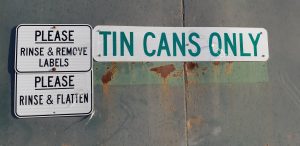Putting the trash out is not easy these days. Householders who are committed to recycling non-biodegradable products such as plastics, metals, paper and cardboard must separate, wash, store and get these items to one or another location for recycling … maybe. In a shocking investigation, a recent CBC Marketplace program looked at final destinations of recycling and cast serious doubt on whether Canadian recycling efforts were worthwhile on any level.
Waste disposal is entangled with economic growth; the market economy; depletion of non-renewable natural resources; disastrous effects on the natural world; fast fashion and fast food; and the spectre of climate crisis.
Busch Systems, a Canadian manufacturer of recycling containers and equipment provides a brief timeline of key events in recycling on its website in a 2017 article by Matt Bradbury. Following are some excerpts (while underlined links to sources are available on the Busch website, BCFHN asks its readers to do their own fact-checking).
500 BCE
Athens organizes the first municipal dump program in the western world
1031 CE
Japan begins the first ever recorded reuse of Waste paper.
1690
The recycled paper manufacturing process is introduced
1865
The Salvation Army is founded in London, England and begins collecting, sorting and Recycling unwanted goods.
1897
New York City creates a materials recovery facility where trash is sorted at “picking yards”
1900S
Recycling advocates and reuse programs embrace the phrase “Waste as Wealth” to describe the revenue to be earned from sorting and reselling items found in household trash.
1904
The first American aluminum can recycling plants open in Chicago and Cleveland.
1916 to 1918
Due to massive shortages of raw materials during World War I, the Federal government creates the Waste Reclamation Service with the motto “Don’t Waste Waste – Save It.”
1930s
Many people survive the Great Depression by peddling scraps of metal, rags and other items.
1940
Goods such as nylon, rubber and many metals are rationed and recycled to help support the war effort.
1955
The August 1st issue of Life magazine offers a two-page article on “Throwaway Living.” Consumers are progressively sold on the idea that single-use items are a necessity of the modern lifestyle.
1964
The all-aluminum can is introduced.
1965 to 1970
The Mobius Loop is introduced as the symbol for Reduce, Reuse, Recycle.
1970
First Earth Day
1971
The first “Bottle Bill” (refundable deposits for beer and soda bottles) is passed in Oregon
Canadian Government established the Department of Environment, commonly referred to as Environment Canada.
1972
Alberta introduced the first province-wide beverage container recycling regulations in Canada.
1983
The first Canadian “blue box” curbside Recycling project is implemented in Kitchener/Waterloo with 1,500 residents participating.
1986
A second municipal blue box Recycling program was started in Mississauga, Ontario. It is considered to be the largest Recycling initiative in North America.
1990
McDonald’s stops using Styrofoam containers. The 20th-anniversary theme for Earth Day is Recycling.
1991
Germany made history when it passed an ordinance shifting responsibility for the entire life cycle of packaging to producers.
1995
Aluminum cans are recycled at a rate of 63% in the U.S. with the highest state-wide rate in California at 80%.
2000
The EPA confirms a link between Global Warming and Waste, showing that reducing our garbage and Recycling cuts down greenhouse gas emissions.
2006
Dell Computer begins offering a free Recycling service for their products—no additional purchases required—sparking the movement of E-waste Recycling.
2012
More than 585 million pounds of consumer electronics are recycled—an increase of 125 million pounds (more than 25 percent) over 2011.
2015
California enacts the first ever state-wide ban on plastic bags in grocery and convenience stores.
2018 – China Import Ban
China enforced several import bans in 2018 that resulted in significant shifts in the Recycling industry. January 1st, 2018: China bans imports of 24 categories of Recyclable Materials. March 1st, 2018: China announces the quality standard that scrap material imports must meet from now on, a 0.5% contamination standard for plastics and fibers.
As of Dec 31st, 2018 – 16 more “solid Waste” scrap materials were banned from importing. The ban of 16 more goes into effect December 31st, 2019.
Reduce – Reuse – Recycle or Do – Make Do – Do without – What Is the Future?
In the past, the expression, “Do – make do – do without” was a common attitude to consumption of household goods. These children’s mitts have been repaired countless times. They reflect a time when textiles were not disposable; when items were more scarce; when money was not as plentiful.
 Two World Wars and the Great Depression in the first half of the twentieth century affected consumption of goods. For example, a 1944 US government advertisement promoting frugality and restraint, depicted a naïve young woman asking why she couldn’t spend all she wanted, since she had the money to do so. The advertisement makes a strong statement about the interconnectedness of people’s choices.
Two World Wars and the Great Depression in the first half of the twentieth century affected consumption of goods. For example, a 1944 US government advertisement promoting frugality and restraint, depicted a naïve young woman asking why she couldn’t spend all she wanted, since she had the money to do so. The advertisement makes a strong statement about the interconnectedness of people’s choices.
How will these issues be resolved?
Less packaging? New Zealand supermarkets have started to remove plastic packaging of fruits and vegetables – they call it food in the nude.
Less purging? Decluttering and eco-living have become catch phrases for getting rid of evidence of overspending and overconsumption. Excess items that don’t “give joy” in the words of Marie Kondo, a decluttering consultant, are donated to charities who are stuck with more items than they can handle.
More personal and government initiative?
Stay tuned. Putting the trash out is a practical, perennial problem that needs to be solved more than ever.




